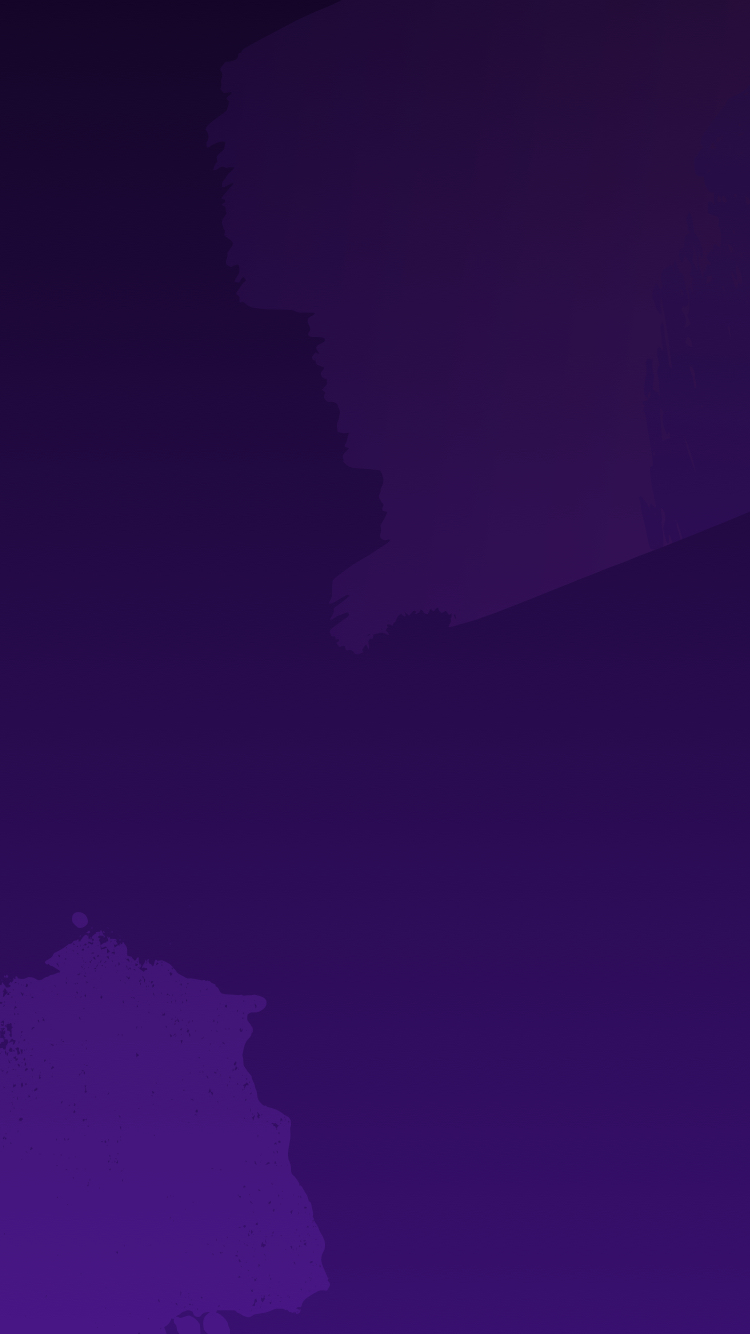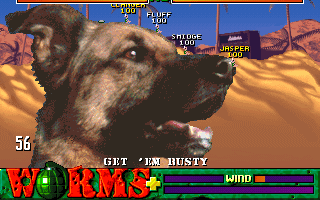Welcome to the latest chapter in our 100th game celebration, in which we journey back to 1996 – a year of great change, when the success of Worms hadn’t yet taken full hold and as our final Amiga releases began to give way to new horizons on PC and console.
Missed a previous chapter? Check out our article on 1995 or start at the beginning in 1991!
27/100
Worms Reinforcements
Year: 1996 | Developer: Team17 | Publisher: Ocean | Format: PC
Buy as part of “Worms United” at GOG.com
Hot on the heels of the PC release of Worms, came this “expansion pack”, which anyone born after 2000 might call “DLC on a disc”! In many ways, Reinforcements was designed to bring PC’s Worms up to the standard of the Amiga release by implementing the custom soundbanks and user-made levels that Commodore gamers were already enjoying, courtesy of ubiquitous software packages like Deluxe Paint. In fact, the CD came pre-loaded with a handful of custom levels made by Team17 staff, some screens for which you can see below.
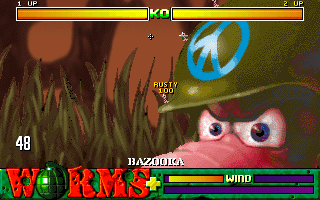
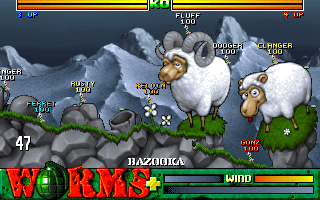
Worms Reinforcements’ biggest and boldest addition, however, was online-play via dial-up modem. Online play in 1996? Colin Surridge, who’s first programming job was on Reinforcements and who still works at Team17 today, recalls the headache… “I remember Reinforcements being worked on and the network game being unfriendly to set up. Back then networks were unfriendly themselves so it was like trying to tame electricity with a cup of water. I think this would have been the biggest challenge and the best addition. Networks were new to everyone so there wasn’t a large pool of knowledge to draw from. Back in 1996 the internet wasn’t yet a source for this kind of information and we only had one machine in the building that was connected to it!”
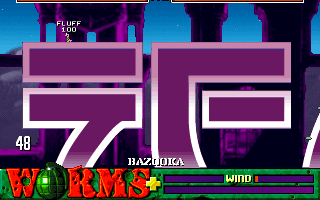
Despite the explosive popularity of Worms, it’s heartening to hear from Surridge how much Team17 still felt like a cottage industry at the time, very much still in touch with its retail and shareware roots. “There are lots of fond memories of that time. I was a lot younger for one thing and had clothes I fit into. Particularly, I liked helping out in the warehouse after work, packing the boxed games for distribution. Everyone helped out regardless of their job, a strong sense of family and mucking in.”
28/100
The Speris Legacy
Year: 1996 | Developer: Binary Emotions | Publisher: Ocean | Format: Amiga, CD32
There should be no prizes for guessing which Nintendo game The Speris Legacy is most often compared to…
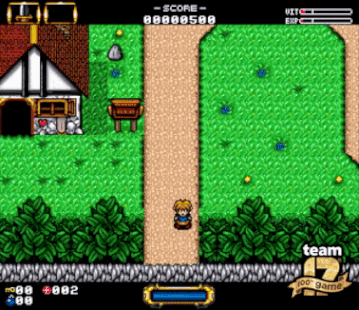
“My brother Ian convinced Clive Minnican and I to do an RPG game, as our first game,” recalls The Speris Legacy designer Andrew Jolly. “I really wanted to do a game based on Scorched Tanks, like Worms, but hindsight is a wonderful thing! We all looked to Japan for inspiration for how we developed games back then and The Legend Of Zelda was obviously the best game to base any RPG success on. Sharma City, the first level, looks the most like Zelda, but the game itself has a totally different speech mechanism. Also we only had a tiny budget and three full-time people working on the actual game development compared to Nintendo’s massive budget and 30+ development team.” The Speris Legacy was nothing if not ambitious.
“Team17 was probably the most approachable games publisher at the time and definitely one of the best,” recalls Jolly. “At that time, most games could not be completed from start to finish, so playability was a big thing and Team17 were one of the few companies that fully play-tested their games from start to finish. I sent a preview build to Martyn Brown and within 24 hours he was on the phone to me, and Speris Legacy was signed up! It took approximately 18 months to develop. Team17 were very flexible and accommodating, we had to release slightly later than scheduled, due to such a small development team and lack of experience on our first game. But, all in all, it was a good experience!”
The Speris Legacy launched to mixed reviews. Hovering around the 70% mark, it was praised for its graphics and controls, but criticised for some obtuse puzzle design. Launching very late in the Amiga’s life, it remains one of our most obscure early releases and one of the hardest to find now – especially in its CD32 incarnation. FOr Jolly, it remains a personal accomplishment. “I still can’t believe how three people in a converted bedroom office managed to pull off an RPG of that size, back then, in 18 months. It took many 16-hour days to do it, and even on that basis, it’s hard to work out how we had enough time! Therefore, the thing I’m most proud of is completing The Speris Legacy with so few people and a tiny budget!”
29/100
World Rally Fever
Year: 1996 | Developer: Split/Team17 | Publisher: Ocean | Format: PC
Buy at GOG.com
As Team17 began to move away from the Amiga, our other passion – Japanese arcade games – hadn’t quite dissipated just yet. Take World Rally Fever, for example. Squint a bit at this sprite-scaling racer and you’d be forgiven for thinking it was Sega’s own Power Drift or Outrunners.
“The main inspiration behind World Rally Fever was obviously the Sega ‘Taikan’ games that were all over arcade halls at the time,” confirms World Rally Fever artist Patrick Romano. “We were in love with those and the sense of speed and punch they conveyed.”
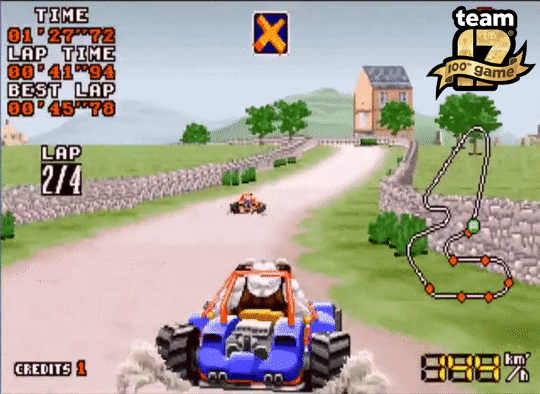
For those who weren’t there at the time, Sega’s sprite-scaling arcade games, like OutRun, Space Harrier or Afterburner used a layered effect to move and scale different chunks of the background in such a way that it created the illusion of fast 3D movement, using only 2D graphics. Even to this day, there’s a bit of a wow factor that comes from the effect, and World Rally Fever had that same factor in spades. It looked amazing, used the effect over a variety of attractive locations and themes, and just begged to be played.
“The biggest challenge,” says Romano, “was making sure the game ran at a constant 60fps on a 486 PC with 4MB of ram in order to recreate an experience comparable to Sega’s monster rides, while keeping as much of a chance of some commercial success. The whole thing was written in assembler, which is kind of a lost, forgotten art really…”
On signing with Team17, Romano explains… “We had done the rounds of French publishers with a half-finished version of the game and although they were interested, we felt they were already up to bigger, more ‘artsy fartsy’ things at the time. The entire industry was in a sense. Team17, however, showed great enthusiasm, and we felt World Rally Fever would be right at home under such an arcade-oriented label.”
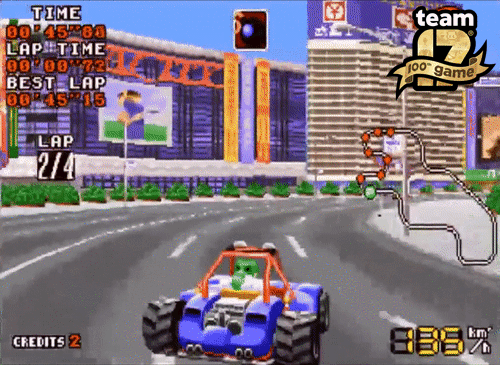
Romano has a lot of positive memories from his time working on World Rally Fever. “Just going round to main programmer, Jean-Marc’s house to see the game’s latest improvements was the best thing. Close second was Martyn’s arcade machine running that Salamander PCB in the cafeteria at Team17 towers. It did see a lot of use when we were up in rainy Ossett finishing development. On the graphics side I was most pleased with the tracks that saw the player racing right through houses in the Japanese gardens stages, none of which could have been done without the coders’ hard work.”
“Another fun fact is that the Wikipedia entry for World Rally Fever stated for the longest time that the game was made by a Japanese dev when we were really three blokes sitting in Brussels!” For a team that loved Sega arcade games and tried to create their own, there can arguably be no greater compliment!
30/100
Alien Breed 3D II: The Killing Grounds
Year: 1996 | Developer: Team17 | Publisher: Ocean | Format: Amiga
After the miraculous technological breakthrough that was 1995’s Alien Breed 3D, it’s understandable that the team would want to push the envelope even further with a sequel. If Doom on the Amiga could be achieved then why not Quake on the Amiga? Alien Breed 3D II reached way farther than you could possibly have imagined at the time.
Essentially developed with heavily expanded “AGA” Amigas in mind, Alien Breed 3D II (or The Killing Grounds as its packaging would have believe the game was really called) came with two versions in the box – one to run on standard Amiga 1200/4000s with 2MB of RAM and another for those lucky enough to own a 4MB expansion. Furthermore, owners of the fancy wave of extremely expensive accelerator cards that were beginning to emerge on the Amiga marketplace could also enjoy improved performance.
On a 2MB Amiga, the game ran in a tiny window with certain visual effects like textured floors and ceilings turned off completely, while on an expanded machine, players could enjoy the game firing on all cylinders and pulling off a technical feat that really should not have been possible on the hardware. But, if we’re honest, it was a game that looked astonishing in screenshots but didn’t live up to the high standard of the Alien Breed series in gameplay. In fact, when editing Team17’s 100th Game Celebration video this year, one of our editors sent back the footage saying, “I think there’s an error in the recording because the frame rate is so low.” There was no error.
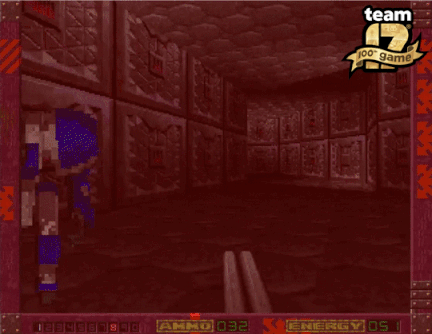
Back in 1996, this bursting of the technical bubble didn’t really matter so much. In fact it was mostly viewed as a strength. After the demise of Commodore and the new gaming age ushered in by PlayStation, support for the Amiga was seriously dwindling and Amiga owners loved that there was still a company out there not only supporting the platform but also achieving the impossible. And the Amiga gaming press was similarly forgiving, with a wave of 90%+ scores. All except Amiga Power, who in their very final issue published a review with a whopping great fake score of 98% at the foot of the page but with a real score of 54% hidden in the body text to punish those readers who always skip the review and go straight to the score. You can read the whole four-page review right here.
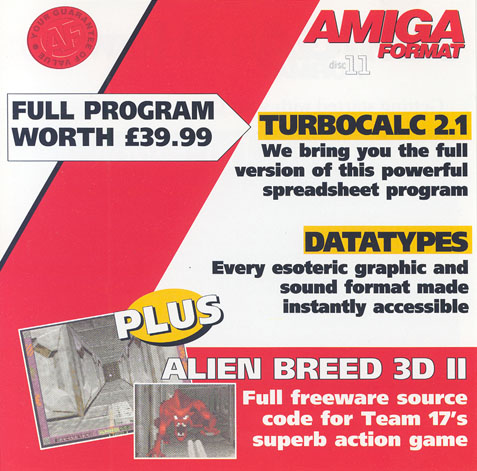
The Killing Grounds source code was actually given away in full on an Amiga Format cover CD in ’97.
“It was really just a ‘so long, and thanks for all the fish’ to the Amiga community,” says Andy Clitheroe. “I know for sure some people hacked in a better graphics converter that sped it up a lot.”
So what went wrong? “The Killing Grounds was a huge mistake!” answers genius programmer Andy Clitheroe. “It should have been Alien Breed 3D made into a proper Alien Breed game, with more time spent on gameplay, features, level-design and story. That would have been great. Instead I wasted all my time upgrading the rendering engine. It was bonkers. Real-time lighting, normal-mapped monsters, relief-mapped floors and ceilings – I needed to just stop.”
Thankfully for Andy, he got his redemption with another technological breakthrough, but you’ll have to wait for our article on 2003 to hear about that. As for Alien Breed, it actually did “just stop” here for a very long time. With the end of the Amiga, the misfire of The Killing Grounds and a new console-centric environment that left Breed at the mercy of third party publishers, it would be over a decade before another Alien Breed game would make it to release. Stay tuned for the story on that one – and some of the cancelled games along the way – another time.
31/100
X2
Year: 1996 | Developer: Team17 | Publisher: Ocean/Capcom | Format: PlayStation
The runaway success of Worms on PlayStation created the opportunity to release even more console games, including this cult sequel to Project X. Unlike its predecessor, X2 featured pre-rendered sprites rather than pixels and looked suitably shiny and futuristic, befitting its sci-fi theme. Displaying all these impressive sprites on PlayStation was no mean feat, though the new CD-ROM format did offer some advantages, as X2 programmer and Team17 co-founder Andreas Tadic explains…
“The first challenged we faced was doing a 2D game on a machine optimised for 3D. The fill-rate, especially with transparency, was not in our favour and parallax scrolling proved a lot harder than I initially anticipated. One of the great things PlayStation did allow though was streaming the backgrounds from CD, so the backgrounds are actually very, very large pictures rather than a level map. Bosses were also streamed from disc, so they could be graphically impressive. Objects were 256 colours, the background 15-bit, which we’d never been able to do before.”
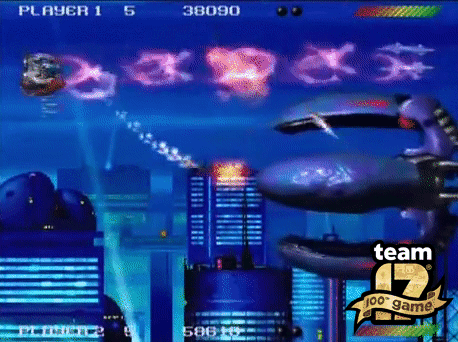
Despite the impressive graphics, unfortunately not everyone was blown away by X2. It was brutally difficult and played quite differently to the Japanese shooters that many console owners preferred. Which is where Capcom, of all companies, stepped in. The house of Street Fighter picked up X2 to publish in Japan, and with their years of experience creating their own arcade shoot-‘em-ups like 1942 or U.N. Squadron, they took the unusual decision to help re-design X2 for Japanese tastes!
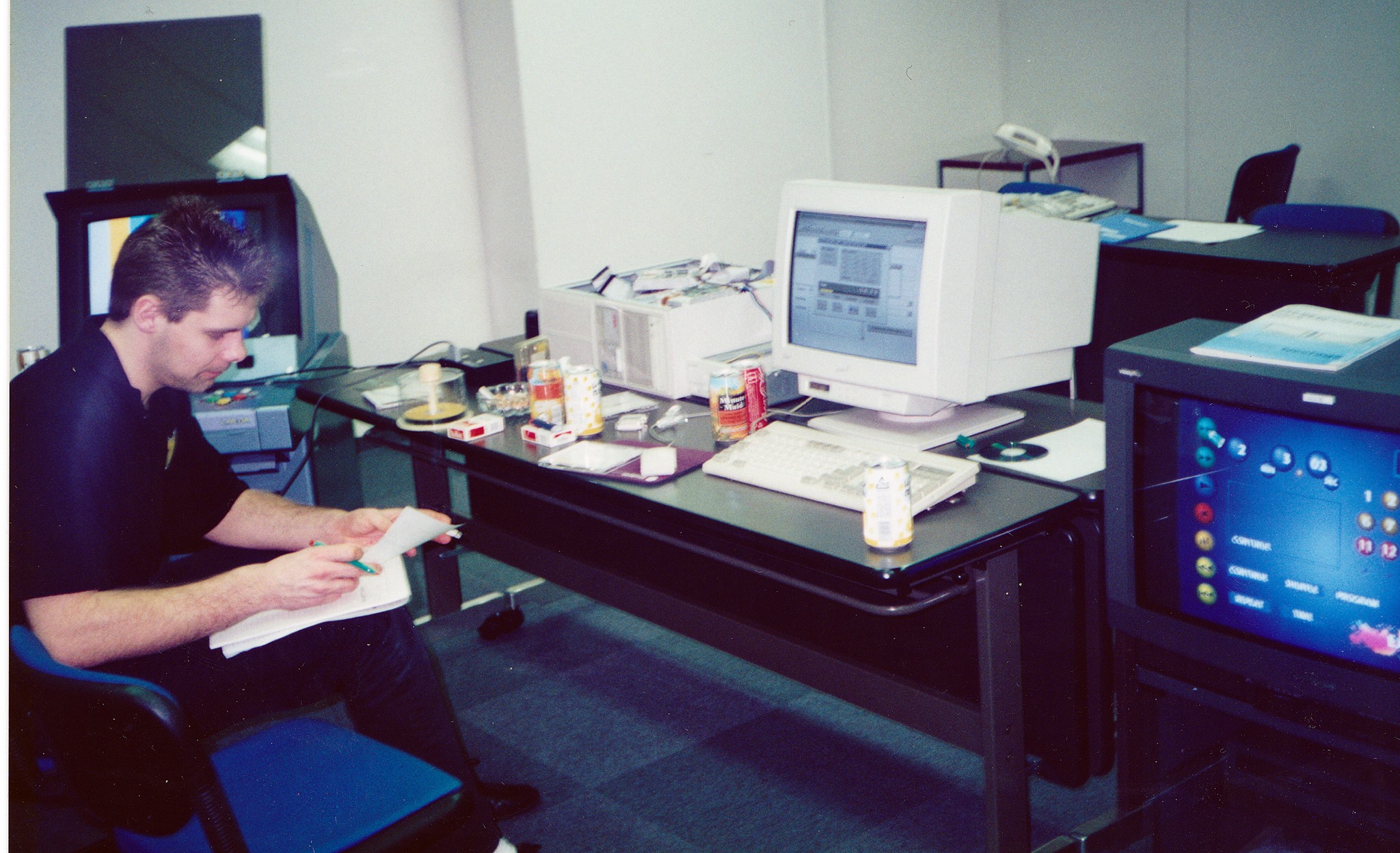
Andreas Tadic deep in the bowels of Capcom’s Osaka HQ, working the improvements to X2.
“We had an in-game debug hud where you could fine-tune the enemies and weapons,” says Tadic, who personally flew over to Capcom HQ in Osaka, Japan to help re-design the game. “The QA team at Capcom used this to tune the game and we then applied those changes. The original game was just too hard, which was a shame. I definitely think what came out from that QA team had much better gameplay.”
Unfortunately, the Capcom release of X2 is extremely hard to find these days. We don’t even have one in the Team17 office! So if you’ve always wanted a sequel to Project X then you’re either in for a hard time tracking down the Japanese release or an even harder time finishing the European one!
That’s all for 1996! In the next chapter we’ll be looking at both 1997 and 1998, with insights into not one but two Worms sequels and a point-and-click adventure starring the Bruce Willis(‘s German dub artist)!
In the meantime, why not check out our article on 1995 or start at the beginning in 1991? We’d also love to hear what your favourite Team17 game is. Let us know on Twitter using #100Team17!
